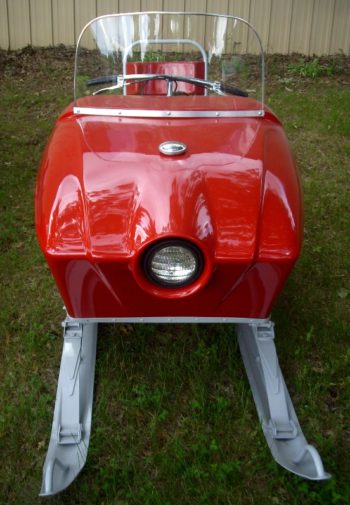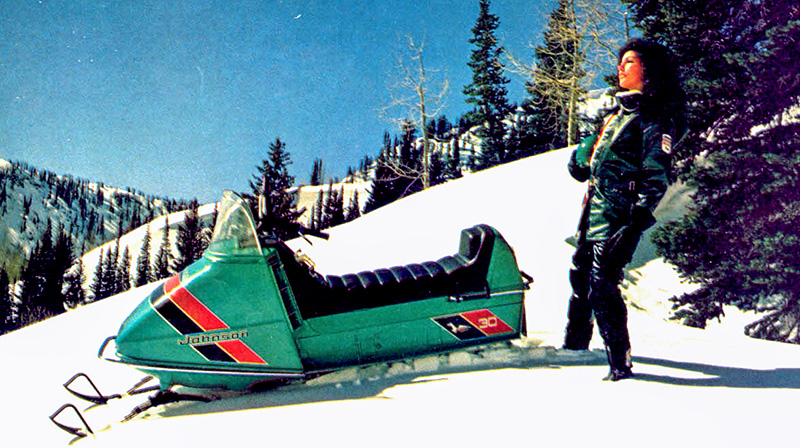
Built by a company that produced large twin-tracked vehicles for oil and mineral exploration, the military and other industrial users, the Robin-Nodwell Snoscoot arrived in 1965 as an early attempt to cash-in on the growing market for snowmobiles.
Conceived to compete with the early Ski-Doo, the original Snoscoot model 503 was a rather basic and really crude product that lacked brakes, bumpers, an ignition switch and even a real muffler. Like many early sleds, it had an exposed and non-lubricated roller drive chain. The gas tank was a fiberglass bowl on the underside of the hood that fed the carburetor by gravity.
Capable of a little over 30 miles per hour, 150 units were built as a market test and the company evaluated them against contemporary competitors.
Convinced they had a winner, the Snoscoot forged ahead.
Idea To Invention
The 1966 model 613 was a slightly improved version of the 503, most notably by adding a simple brake (although it is possible that not every model 613 received one).

Two marketing channels were established for the machine: a distributor/dealer channel would handle the Snoscoot (which had a red hood and single headlight), while Canadian mass-marketer Simpson-Sears would handle a version called the Snow King (differentiated by a light-blue hood and twin headlights). Marketing support included full-color sales literature and ad slicks that dealers used in local newspapers.
Seemingly nobody knows exactly how many of either ’66 models were built; reports range from 100 to 400 total units, with the latter being more believable. This turned out to be the high point for Snoscoot production.
Reliable geographic distribution was obtained for the distributor/dealer channel, with several Snoscoot dealerships established in New York and reportedly into New England. There were also Canadian dealerships in Ontario and Quebec.
Some say most of the production went to the east, although a dealership was also established in Fairbanks, Alaska, and many models stayed on the Canadian prairie for the Calgary-company.
This Isn’t Working
The ability of the Snoscoot to reach consumers suffered numerous problems, with engineering subpar to the standards of Robin-Nodwell’s industrial equipment.
The Snoscoot’s steering column was made of thin tubing and easily twisted or broke. The chassis frequently failed at the driven clutch mounting, sometimes due to the gross misalignment of the clutches during manufacturing. All the primitive clutches during this era were headaches, and the gas tank was too close to the exhaust system (presenting a fire hazard).
From the manufacturer’s perspective, Robin-Nodwell was unable to build the product at a low enough cost to meet its financial goals for the product, while keeping the retail price competitive.
The Snow King turned out to be one of the first “one-year-wonder” sleds, being discontinued by Simpson-Sears. No other mass manufacturer took the sled on.
At the time, Robin-Nodwell’s newly established Snowmobile Division under Alex Duthie needed to sell 8,000 units per year to allow the company to make a profit on the sleds; company officials were beginning to realize that the rapidly-growing snowmobile market was going to be a much tougher nut to crack than they first believed.
 And so for the 1967 season a new and improved model 713 appeared.
And so for the 1967 season a new and improved model 713 appeared.
A new hood with a headlight in a chrome bezel, a two-color seat with an upholstered backrest to replace the hard fiberglass passenger back support found in earlier models and a larger fiberglass rear storage compartment gave it a fresh, yet familiar appearance.
Other improvements included a front bumper and passenger handgrips, a steel gas tank in the front of the chassis (as a safety upgrade) and an optional 15.5 hp 292cc JLO engine was added to the line. Some blue-hood Snoscoots were offered for sale, but apparently none have survived.
Sales were slow, and so Duthie set up a factory clearance sale, effective February 1, 1967, with cash terms on all sleds and related items including Snoscoot covers and unique single trailers that hauled the sleds mounted backwards.
It didn’t seem to make much of a difference. In fall of 1967, Montreal-based aircraft manufacturer Canadair acquired Robin-Nodwell. A handful of 1968 model 813 Snoscoots were apparently built prior to the acquisition, including some model 813S units powered by an 18 hp Sachs 297 featuring a slightly larger gas tank.
With many 1967 Snoscoots still unsold, Canadair quickly halted snowmobile production. In the summer of 1968, Jamie E. Jacobs of Colchester, Vermont, acquired all remaining Snoscoot inventory and his company, Iroquois Manufacturing, rebuilt them for liquidation as the 1969 Iroquois Sno-Rover.
Robin-Nodwell’s assessment that the snowmobile market was poised to take off was correct, but the company was unable to deliver a quality product at a competitive price to turn a profit. As a result, the brand failed.
Even though it’s likely that less than a thousand Robin-Nodwell Snoscoots were built, some of them are still around today. Look carefully at vintage shows and you just might see one of these early pioneers of the conventional sled layout.
Editor’s Note: This Flashback article from International Snowmobile Hall of Fame writer David Wells first appeared in Snow Goer magazine. To see more of Wells’ great articles on interesting old sleds, plus in-depth new sled evaluations, aftermarket product tests, informative how-to story, interesting travel features, Snowmobile Science articles and much more, subscribe to Snow Goer magazine.







I grew up in Calgary, home of Robin Nodwell, and worked assembling the last year of production of the Snowscoot there. We were short staffed and had to work 12 hours per day and 8 hours on a Saturday to get the production finished in time. i loved it because the pay was great. After the production closed for the year they were still trying to develop a better sled and we tested even in the summertime with newer engines and better suspensions. The market was flooded by better sleds so they decided to sell off the sleds and that was it…
I am looking to purchase a 1967 Snowscoot, we were their dealer back in the 60’s and I would like to find one to display in our showroom. Please contact me if you are looking to sell one in any condition.thx
Rob Snyder
Eastern Farm Machinery Ltd.
Are you still looking for a snowscoot? I just happen to come across one
Was wondering are you still looking for a snow scoot?